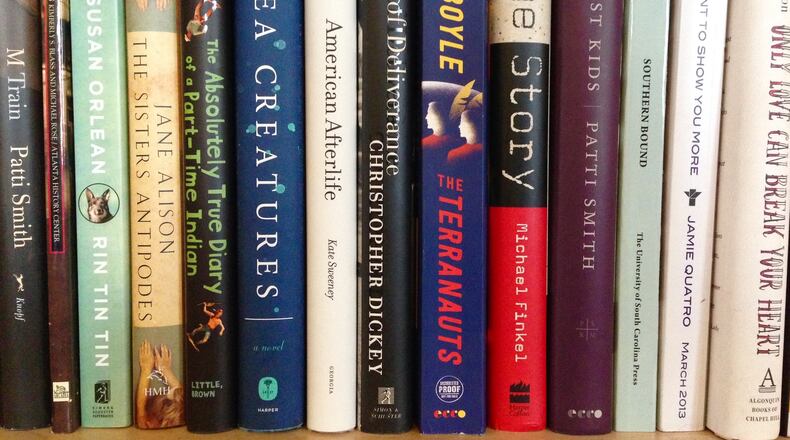In less skilled hands, it might seem melodramatic to suggest, as Bryn Chancellor does in her debut novel "Sycamore," that the sudden and inexplicable disappearance of 17-year-old Jess Winters from Sycamore, Arizona, would unravel the fabric of an entire town. But 18 years later, when human remains discovered in the dry bed of a lake are believed to belong to Jess, the fear and agony that racked the community at the time of her disappearance returns with a vengeance, and neighbors, coworkers and Jess' classmates are forced to revisit the ways in which they may have been complicit in her probable fate.
Jess and her mother Maud relocate from Phoenix to northern Arizona for a fresh start in January 1991. It’s a bumpy transition for them both. Gangly in her 5-foot-10-inch frame, Jess enrolls halfway through the school year at Sycamore High. Students vandalize her locker with profanity, and hostile cliques shut her out. “About the same as in Phoenix: plenty of (expletive)-kickers, jocks and cheerleaders overly fond of hair spray.”
But Jess, a wanderer and prolific writer, copes by taking hours-long nighttime walks and penning verses in her notebook. “Here: A new home / small and minty / with salted black hills / tiny speck on the pale blue dot / You are here / Dog-ear the page for yourself / don’t lose your place / For god’s sake / don’t disappear.”
Meanwhile her mother Maud, a letter carrier for the U.S. Postal Service, treks through the grid streets of her route, “satchel thumping at her hip,” in a grief-stricken fog. Her messy divorce and her ex-husband’s quick second marriage and child with his new wife have depleted her mental reserves. When she returns home from work, she sleeps, largely oblivious to Jess’ comings and goings. After Jess disappears, Maud wonders if it’s her own fault, if she wasn’t an attentive enough mother, the kind of mother her daughter deserved. Each day Maud waits for news, she tortures herself with thoughts of what might have happened to her only child. “There were the imaginings, the speculation about what had happened: body snatched, body bloated, body burned, body naked, body floating, body bleeding, body buried alive. Maud’s counselor taught her how to replace her terrible images with a more positive one: Mexico, their family vacation spot before the divorce, the last place they’d traveled together the summer before Jess disappeared. The last place Maud remembered Jess being happy.”
Chancellor, an English professor at the University of North Carolina-Charlotte, is a patient and skillful scribe. She deftly dissects the lives of more than a dozen characters who come into contact with Jess during the 12 months she lives in Sycamore. With a few opening words in each chapter, we’re immersed in their worlds and the hefty burdens of their years-long emotional struggle.
Angie Juarez, whose unrequited love for Jess in high school caused a falling out between them, is haunted by a guilt that plays through her mind on an endless loop. “What if I’d been a better friend? What if I’d told her? What if she’d say yes? What if I’d seen her that night?” Stevie Prentiss is one of the last people to see Jess alive. “I should have looked for you. I should have called the police. I should have called your mother. I should have realized, she’s not thinking straight. I should have done more.”
Angie, Stevie and the other residents of Sycamore are sinking in quicksand and can’t seem to get their footing. They waffle between inertia and irrationality. Relationships fizzle, feelings of betrayal fester, dreams dissolve. Jess’ brainy best friend Dani Newell drops out of Stanford and returns to Sycamore with her tail between her legs. “She thought now that time wasn’t so much flying as disintegrating. … Moments fractured into shards of color and smell and sound she strung together like a sad, crooked garland. … She simply locked all the hot, lovely parts of herself away.” Paul Overton, Dani’s ex-boyfriend, faces more tragedy as an adult, and has mixed feelings about returning home to his roots, to a past he prefers never to think about again. “Because too many people he loved were gone, buried in the earth, leaving him – boy turned man, man turned father, but still a son, always.”
“Sycamore” is no adrenaline-fueled episode of “Unsolved Mysteries” with an eerie soundtrack. Chancellor creates suspense and tension in quiet, insular moments – family members brooding at the dinner table, lustful gazes, the rolled eyes of hormonal teenagers in the hallways of the local high school and the anguish of having to wait days, weeks, months, and years to learn the whereabouts of a beloved child, as Maud does. “After 18 years, every time she opened her own mailbox, she still held her breath. Every time, she shuffled through the envelopes, looking for the scrawl she knew by heart. Every time, nothing.”
Perhaps this is Chancellor’s point. Overcoming tragedy is a near impossible feat. Just when the healing process affords some semblance of peace, something triggers the trauma all over again. Maud comes to realize, though, that she must find a way to exist in a world that continues to revolve around the sun, despite her own, personal pain. “Here she was, facing her future, whether she wanted to or not.”
MORE BOOK REVIEWS
FICTION
‘Sycamore’
By Bryn Chancellor
Harper
336 pages, $26.99
About the Author
Keep Reading
The Latest
Featured





